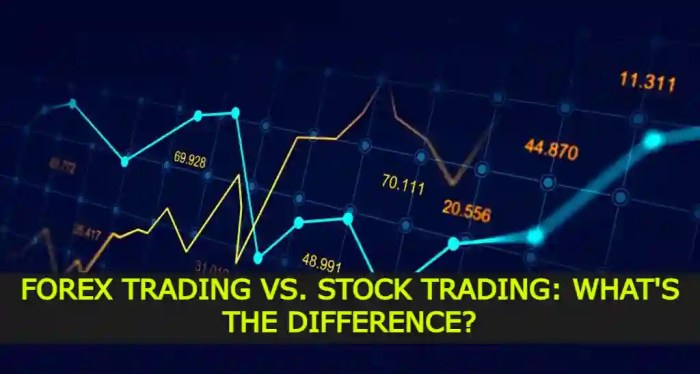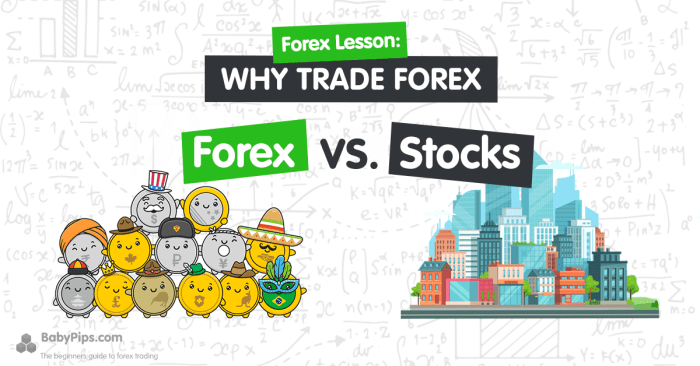
What is forex trading vs stock trading? This seemingly simple question unlocks a world of financial opportunity and risk. Both involve buying and selling assets to potentially profit, but the underlying assets – currencies versus company shares – drastically alter the playing field. We’ll dive deep into the core differences, from market access and trading strategies to risk profiles and transaction costs, equipping you with the knowledge to navigate these exciting, yet complex, markets.
Understanding the nuances between forex and stock trading is crucial for any aspiring investor. This isn’t just about choosing between two investment vehicles; it’s about understanding your risk tolerance, investment goals, and the time you’re willing to dedicate. From the fast-paced world of currency exchange to the more measured approach of stock picking, we’ll break down the key factors to help you make an informed decision.
Defining Forex and Stock Trading
Forex and stock trading, while both involving financial markets, operate on fundamentally different principles and assets. Understanding these core differences is crucial for anyone considering venturing into either arena. Both offer potential for profit, but also carry significant risk. Let’s break down the basics.
Forex trading, short for foreign exchange trading, is the global marketplace for exchanging national currencies. It’s a decentralized, over-the-counter (OTC) market, meaning there’s no central exchange like a stock exchange. Instead, transactions happen directly between two parties, facilitated by banks, brokers, and other financial institutions. The core action is speculating on the value of one currency against another – essentially betting on which currency will appreciate or depreciate in value relative to the other.
Forex Trading: Currency Exchange
Imagine you’re traveling internationally. You need to exchange your US dollars for Euros to buy souvenirs in Paris. That’s a simplified version of forex trading. However, forex traders aren’t typically buying Euros to spend; they’re buying and selling currencies with the aim of profiting from fluctuations in exchange rates. These fluctuations are influenced by a myriad of factors, including economic news, political events, and interest rate changes. A trader might buy Euros when they believe the Euro will strengthen against the dollar, hoping to sell them later at a higher price, thus realizing a profit.
You also can understand valuable knowledge by exploring fidelity forex trading.
Stock Trading: Company Ownership
Stock trading, on the other hand, involves buying and selling shares of publicly traded companies. When you buy a stock, you’re essentially purchasing a small piece of ownership in that company. The price of a stock fluctuates based on factors such as company performance, market sentiment, and industry trends. Unlike forex, which is a 24/5 market, stock trading operates within specific exchange hours.
Underlying Assets: A Comparison
The fundamental difference lies in the underlying assets. Forex trading focuses on currencies – intangible units of value representing national economies. Stock trading, conversely, deals with shares of companies – representing ownership in tangible assets, businesses, and their future potential. This distinction leads to different risk profiles and trading strategies. Currency values are influenced by macroeconomic factors, while stock prices are influenced by a combination of microeconomic (company-specific) and macroeconomic factors.
Market Participants
Both forex and stock markets involve a range of participants. In forex, these include central banks, commercial banks, hedge funds, corporations, and individual traders. Brokers act as intermediaries, facilitating transactions. In stock trading, participants include institutional investors (mutual funds, pension funds), individual investors, and brokerage firms. Both markets have market makers who provide liquidity and facilitate trading. However, the scale and global reach of the forex market dwarf those of the stock market, making it the world’s largest and most liquid market.
Market Accessibility and Entry Barriers

So, you’re ready to dive into the world of trading, but forex and stocks both beckon. Which path is easier to navigate? The answer, as with most things in life, is “it depends.” Both markets offer lucrative opportunities, but their accessibility and the hurdles you’ll face differ significantly. Let’s break down the key differences.
Choosing between forex and stock trading often hinges on your resources, risk tolerance, and trading style. Understanding the market’s accessibility and the barriers to entry is crucial before committing your capital and time. The regulatory landscape, minimum capital requirements, and overall ease of access all play a pivotal role in this decision.
Minimum Capital Requirements
The amount of capital needed to start trading in forex and stocks varies considerably. Forex trading, thanks to leverage, is often touted as more accessible for beginners. You can start with a relatively small amount, sometimes as low as a few hundred dollars, although leveraging amplifies both profits and losses significantly. In contrast, stock trading typically requires a larger initial investment. While you can buy fractional shares, building a diversified portfolio with a meaningful position in several stocks demands a substantially higher capital outlay, often in the thousands of dollars. This difference reflects the inherent risks and complexities of each market; the higher the potential return, the higher the initial investment often required.
Regulatory Frameworks
Navigating the regulatory landscape is another key difference. Forex trading is largely unregulated in many jurisdictions, especially for retail traders. While some regulatory bodies oversee certain aspects, the lack of centralized oversight can lead to increased risks, including scams and fraudulent activities. Stock markets, on the other hand, are typically heavily regulated by national or regional authorities. These regulations aim to protect investors, maintain market integrity, and ensure transparency. This regulatory oversight offers a degree of investor protection not always present in the forex market. For example, the Securities and Exchange Commission (SEC) in the United States and the Financial Conduct Authority (FCA) in the UK provide robust frameworks for stock trading, but forex traders often rely on self-regulation and broker oversight, which can be less stringent.
Ease of Access for Retail Investors
Accessibility for retail investors varies drastically. Opening a forex trading account is generally quicker and simpler than setting up a brokerage account for stock trading. Many forex brokers offer streamlined online registration processes, requiring minimal documentation. In contrast, opening a stock brokerage account often involves more stringent Know Your Customer (KYC) and Anti-Money Laundering (AML) compliance checks. This increased scrutiny, while potentially inconvenient, contributes to the greater regulatory protection offered in stock markets. The ease of accessing trading platforms also differs; forex trading platforms are generally user-friendly and widely available, while stock trading platforms might require more technical knowledge to navigate effectively.
Barriers to Entry
Several barriers to entry exist in both forex and stock trading. In forex, the lack of stringent regulation, the high leverage potential leading to substantial losses, and the complexity of global macroeconomic factors pose significant challenges. The psychological pressures of trading on margin and the 24/5 market dynamics can also prove overwhelming for inexperienced traders. For stock trading, the higher initial capital requirements, the need for in-depth market research, and the complexities of fundamental and technical analysis are significant hurdles. Understanding financial statements, company valuations, and market trends takes time and effort. Additionally, the emotional toll of navigating market volatility can be considerable. Both markets require significant dedication to learning and managing risk effectively.
Trading Mechanisms and Strategies
Forex and stock trading, while both involving the buying and selling of assets to profit from price fluctuations, differ significantly in their mechanisms and the strategies employed. Understanding these differences is crucial for success in either market. This section will delve into the common strategies and the role of leverage/margin and technical/fundamental analysis in both forex and stock trading.
Common Forex Trading Strategies
Forex trading, characterized by its high liquidity and 24/5 availability, lends itself to a variety of strategies, often focusing on short-term price movements. Many traders utilize technical analysis heavily, relying on chart patterns and indicators to identify entry and exit points.
- Scalping: This strategy involves profiting from small price changes over very short periods, often holding positions for only seconds or minutes.
- Day Trading: Positions are opened and closed within the same trading day, capitalizing on intraday price swings.
- Swing Trading: This involves holding positions for several days or weeks, aiming to capture larger price movements.
- Position Trading: A long-term strategy where positions are held for months or even years, based on fundamental analysis and long-term market trends.
- Carry Trade: This strategy exploits interest rate differentials between two currencies. Borrowing in a low-interest-rate currency and investing in a high-interest-rate currency can generate profits, but carries significant currency risk.
Common Stock Trading Strategies
Stock trading, in contrast, offers a wider range of investment horizons and strategies, from short-term speculation to long-term value investing. While technical analysis plays a role, fundamental analysis, which examines a company’s financial health and prospects, is often more heavily weighted.
- Growth Investing: Focusing on companies with high growth potential, often sacrificing current dividends for future capital appreciation.
- Value Investing: Identifying undervalued companies whose stock prices are below their intrinsic worth, based on thorough fundamental analysis.
- Momentum Investing: Capitalizing on stocks that are experiencing significant price increases, aiming to ride the wave of upward momentum.
- Dividend Investing: Prioritizing companies that pay regular dividends, providing a steady stream of income.
- Index Fund Investing: A passive strategy that involves investing in a diversified portfolio of stocks that mirrors a specific market index, such as the S&P 500.
Leverage in Forex vs. Margin in Stocks
Both forex and stock trading utilize leverage/margin to amplify potential profits (and losses). In forex, leverage magnifies the trader’s purchasing power, allowing them to control a larger position with a smaller initial investment. For example, a 1:100 leverage allows a trader to control $100,000 with only $1,000 of their own capital. Margin in stock trading serves a similar purpose, allowing investors to borrow a portion of the purchase price from their broker. However, the leverage offered in forex is generally significantly higher than margin in stock trading. The higher leverage in forex trading increases the potential for both substantial gains and significant losses.
The Role of Technical and Fundamental Analysis
Technical analysis, which involves studying price charts and historical data to identify patterns and trends, is widely used in both forex and stock trading. However, its application varies. In forex, technical analysis is often dominant, given the market’s continuous and highly liquid nature. In stock trading, fundamental analysis, which examines a company’s financial statements, management team, industry position, and overall economic environment, plays a more significant role, especially in long-term investment strategies. While both types of analysis can be used independently, combining both often provides a more comprehensive and informed trading approach.
Risk and Reward Profiles
Forex and stock trading, while both offering the potential for significant returns, present vastly different risk profiles. Understanding these nuances is crucial before diving into either market. The higher the potential reward, the higher the risk involved, and this principle holds true for both forex and stocks. Let’s delve into the specific risk and reward characteristics of each.
Forex Trading Risks
Forex trading, with its high leverage and 24/5 market availability, exposes traders to significant risks. The sheer volume and speed of transactions can lead to rapid losses if positions aren’t managed effectively. Geopolitical events, economic news releases, and unexpected market shifts can dramatically impact currency values, creating substantial volatility. Furthermore, leverage, while magnifying profits, also magnifies losses. A small movement against your position can quickly wipe out your trading capital if you’re highly leveraged. The lack of a central regulatory body for the forex market adds another layer of complexity, making it crucial to choose reputable brokers and understand the risks involved. For example, a sudden political crisis in a major country could trigger a sharp devaluation of its currency, causing significant losses for traders holding long positions in that currency.
Stock Trading Risks and Rewards
Stock trading offers the potential for substantial long-term gains through capital appreciation and dividends. However, the market is subject to fluctuations influenced by company performance, economic conditions, and investor sentiment. Individual stocks can be highly volatile, especially those of smaller companies or those in emerging sectors. Market downturns can lead to significant losses, and even well-established companies can experience periods of decline. Risks are mitigated somewhat by diversification—spreading investments across multiple stocks and sectors—but complete elimination of risk is impossible. For instance, a company’s unexpected earnings miss could trigger a sharp drop in its stock price, impacting investors holding shares. Conversely, a successful product launch or positive economic news can lead to substantial gains.
Volatility Comparison
Forex markets are generally considered more volatile than stock markets. Currency values react swiftly to news and events, often exhibiting sharp and rapid price swings. Stock markets tend to be less volatile in the short term, but can experience significant fluctuations over longer periods, particularly during economic recessions or periods of heightened uncertainty. The speed and magnitude of price changes in forex make it a higher-risk, higher-reward environment compared to the stock market. For example, a major economic announcement can cause the value of a currency to fluctuate by several percentage points in a matter of minutes, while a similar announcement might only cause a single-digit percentage change in a stock’s price over the course of a day.
Risk, Return, and Time Horizon Comparison
| Factor | Forex Trading | Stock Trading |
|---|---|---|
| Risk Level | High (due to leverage, volatility, and lack of central regulation) | Medium to High (depending on diversification and stock selection) |
| Potential Returns | Potentially very high (but also potentially very low) | Potentially high (but requires a longer-term perspective) |
| Time Horizon | Short-term to medium-term (though long-term strategies exist) | Medium-term to long-term (though short-term trading is possible) |
Market Hours and Liquidity

The forex and stock markets operate on vastly different schedules, impacting trading strategies and risk management. Understanding these differences is crucial for any trader, whether seasoned or novice. The sheer volume of trading activity, or liquidity, also varies significantly between the two, influencing price volatility and execution capabilities.
Forex trading, unlike the stock market, never truly closes. It operates 24 hours a day, five days a week, across different global financial centers. This continuous operation stems from the decentralized nature of the forex market, with trading occurring across multiple time zones. This constant activity means there’s always a market open somewhere in the world. Conversely, stock exchanges operate on specific, limited hours.
Forex Market Operating Hours, What is forex trading vs stock trading
The forex market’s continuous operation is a double-edged sword. While it offers ample opportunity for trading at any time, it also requires constant monitoring and adaptation to changing global events that can impact currency values. The market’s liquidity tends to be highest during the overlap of trading sessions in major financial centers like London, New York, and Tokyo. This creates periods of peak activity, where trading volume and price movements are typically more significant. Conversely, periods of lower overlap often show reduced liquidity and volatility. For example, during the Asian trading session (before the London session opens), the market might be relatively quieter compared to the overlap of London and New York sessions.
Major Stock Exchange Operating Hours
Major stock exchanges around the world operate during specific business hours within their respective time zones. The New York Stock Exchange (NYSE), for instance, typically operates from 9:30 AM to 4:00 PM Eastern Time. Similarly, the London Stock Exchange (LSE) operates during its own business hours, which overlap with the NYSE for a few hours each day. The Tokyo Stock Exchange (TSE) operates during Asian business hours, preceding the European and American sessions. This segmented operation limits trading opportunities to specific windows, impacting trading strategies. A trader in New York, for example, cannot trade on the TSE outside its operating hours.
Liquidity Comparison: Forex vs. Stock Markets
The forex market boasts significantly higher liquidity than most individual stock markets. This is primarily due to its massive trading volume and the involvement of major players like central banks and multinational corporations. The daily trading volume in the forex market dwarfs the daily trading volume of even the largest stock exchanges. This high liquidity generally translates to tighter spreads (the difference between the bid and ask price) and easier order execution, particularly for larger trades. However, even within the forex market, liquidity varies across currency pairs. Major pairs like EUR/USD typically exhibit higher liquidity than more exotic pairs. Stock market liquidity, on the other hand, varies widely depending on the specific stock. Highly liquid stocks, often those of large, well-established companies, are easier to buy and sell than less liquid stocks, which can experience wider spreads and potentially slower execution.
Implications of Market Hours and Liquidity on Trading Strategies
The differences in market hours and liquidity significantly influence trading strategies. Forex traders often employ strategies that capitalize on the market’s 24-hour operation, such as scalping (short-term trades) or swing trading (medium-term trades) that leverage the high liquidity during overlapping sessions. Conversely, stock traders must plan their trades around the specific operating hours of the exchanges. High-frequency trading strategies, for instance, are more common in the stock market due to its relatively higher transaction costs compared to forex, which necessitate frequent trades to achieve profitability. The liquidity differences also dictate order sizes and risk management approaches. Larger trades can be executed more easily in the forex market due to its high liquidity, while stock traders may need to break down larger orders to avoid impacting the market price.
Transaction Costs and Fees: What Is Forex Trading Vs Stock Trading
Navigating the worlds of forex and stock trading requires understanding the often-hidden costs involved. These fees, while seemingly small individually, can significantly impact your overall profitability over time. Let’s break down the expenses you can expect in each market.
The cost of trading in forex and stocks isn’t just about the price of the asset itself; it also includes various fees and commissions charged by brokers and other intermediaries. Understanding these costs is crucial for effective risk management and maximizing your returns. While both markets involve transaction costs, the nature and amount of these costs differ significantly.
You also can understand valuable knowledge by exploring forex trading fees.
Forex Trading Fees
Forex trading fees primarily revolve around the spread, which is the difference between the bid and ask price of a currency pair. Brokers profit from this spread, and it’s often the primary cost associated with forex transactions. Some brokers may also charge commissions, though this is less common than in stock trading. Other potential fees include overnight swap fees (for holding positions open overnight), inactivity fees, and withdrawal fees. The overall cost of forex trading can be relatively low, especially for active traders who focus on short-term trades. However, the cumulative effect of spreads over numerous trades can be substantial. It’s important to compare spreads across different brokers to find the most competitive pricing.
Stock Trading Fees
Stock trading fees are more varied and generally higher than forex trading fees. The most common fee is the brokerage commission, which is a percentage or fixed fee charged per trade. Other potential fees include regulatory fees, transfer fees (for moving stocks between brokers), and potentially margin interest if you’re trading on margin (borrowing money to buy stocks). Discount brokers often offer lower commissions, but full-service brokers may charge higher fees in exchange for research and advisory services. The total cost of stock trading depends heavily on the broker chosen, the frequency of trades, and the size of the trades.
Comparison of Transaction Costs
Understanding the differences in transaction costs is vital for choosing the right market for your trading style and risk tolerance. Forex trading generally boasts lower transaction costs, especially for active traders, primarily due to the prevalent use of spreads rather than explicit commissions. However, stock trading fees are more transparent and often involve a combination of commissions and other fees. The overall cost depends on the specific broker, trading strategy, and frequency of trades.
Here’s a bulleted list summarizing the typical transaction costs in both markets:
- Forex Trading: Primarily spreads (difference between bid and ask price); potentially overnight swap fees, inactivity fees, and withdrawal fees. Commissions are less common.
- Stock Trading: Brokerage commissions (percentage or fixed fee per trade); regulatory fees; transfer fees; margin interest (if applicable).
Illustrative Examples of Trades

Understanding the nuances of forex and stock trading requires looking beyond the theory. Let’s examine some hypothetical scenarios to illustrate the potential for profit and loss in both markets. These examples are simplified for clarity and do not encompass all the complexities of real-world trading.
Successful Forex Trade
Imagine you believe the Euro (EUR) will strengthen against the US dollar (USD). You analyze economic indicators suggesting robust European growth and a weakening US dollar. You decide to buy 10,000 EUR/USD at an exchange rate of 1.1000 (meaning 1 EUR costs 1.10 USD). This is a long position. Over the next week, positive economic news boosts the Euro, and the EUR/USD exchange rate rises to 1.1100. You decide to sell your 10,000 EUR at this new rate. Your profit is calculated as follows: (1.1100 – 1.1000) * 10,000 = $100. This is a simplified calculation and doesn’t account for any commissions or spreads.
Successful Stock Trade
Let’s say you’re bullish on a tech company, “InnovateTech” (ITK), whose stock is trading at $50 per share. After researching the company’s financials and market position, you believe its innovative product will drive significant growth. You buy 100 shares of ITK. Over the next three months, InnovateTech releases a successful new product, exceeding market expectations. The stock price rises to $75 per share. You sell your 100 shares, realizing a profit of ($75 – $50) * 100 = $2,500. Again, this is a simplified example and doesn’t include commissions or taxes.
Unsuccessful Forex Trade
In contrast, consider a scenario where you predict the Japanese Yen (JPY) will appreciate against the USD. You buy 1,000,000 JPY/USD at an exchange rate of 110 (meaning 1 USD buys 110 JPY). Unexpectedly, negative economic news hits Japan, leading to a decline in the JPY. The exchange rate moves against you to 112 (meaning 1 USD now buys 112 JPY). You decide to cut your losses and sell. Your loss is calculated as the difference in the exchange rate multiplied by the amount of JPY you bought, which results in a loss. This loss is compounded by the large position size.
Unsuccessful Stock Trade
Suppose you invest in “RetailGiant” (RTG) at $100 per share, believing its recent marketing campaign will boost sales. However, the campaign fails to generate the expected results, and negative economic conditions impact consumer spending. The stock price drops to $80 per share. You sell your shares, incurring a loss of ($100 – $80) * (Number of Shares Owned). The loss magnitude depends on the number of shares you purchased.
Profit/Loss Potential Comparison
Imagine two bars representing potential profit/loss. For the successful Forex trade, the bar representing profit might be shorter than the bar representing the successful stock trade profit. The length of the bars reflects the relative magnitude of the profit. Similarly, the bars representing losses in both trades could be depicted, with their lengths reflecting the size of the losses incurred. The key takeaway is that while both markets offer substantial profit potential, they also carry significant risk, and losses can be substantial. The size of potential gains or losses depends heavily on the amount invested, leverage (in forex), and market movements.
Ending Remarks
So, forex versus stocks? The choice ultimately depends on your individual circumstances and financial goals. Forex offers high liquidity and leverage, appealing to those seeking quick profits but accepting higher risk. Stocks, while potentially less volatile in the long run, require a deeper understanding of individual companies and market trends. By carefully weighing the pros and cons Artikeld above, you can confidently choose the path that best aligns with your investment strategy and risk appetite. Remember, thorough research and a well-defined plan are your best allies in either market.






